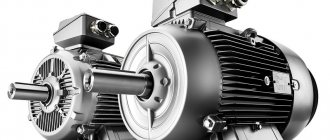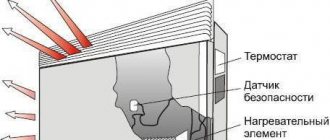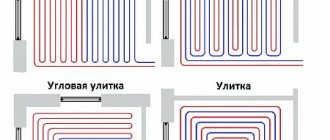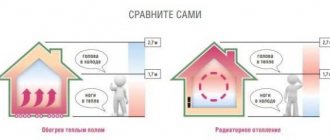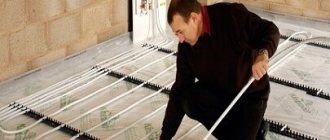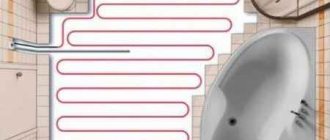Waking up on a frosty winter morning and putting your bare feet on the floor, you immediately feel the desire to hide under the covers again and hibernate, at least until spring. For this reason, many people install heated floors that provide comfort at any time of the year. Moreover, the most popular is electric heated floors, which are easy to install and safe to use. How does such a system work, what are its advantages, and how does it differ from other heating systems?
Classification of warm electric floors
How the system works
The surface of a warm floor is a kind of panel that evenly radiates heat around the perimeter of the room. And the electric heated floor itself, in fact, is wires placed in the screed or under the ceramic tiles. Electricity supplied to the wires is converted into thermal energy. Other electrical appliances, including electric kettles, work in a similar way.
Types of electric heated floors
A distinctive feature of this system is the presence of a thermostat, which, when overheated, automatically turns off the system from power.
Cable heated floor
Companies producing underfloor heating systems care about the comfort of consumers of their products, and therefore produce cables in a wide range. They can be:
- single-core;
- two-core;
- self-regulating.
Types of cable heated floors [ads-mob-1][ads-pc-1]
Features of single-core cables
These are the simplest devices used for heating rooms. They are affordable and work according to the principle used in most household appliances. That is, a single-core cable is an ordinary spiral enclosed in insulation.
Diagram of laying a single-core cable for floor heating
Such a cable consists of one metal core that performs two tasks simultaneously: it is both a conductor and a heating element. And in order to reduce electromagnetic radiation to a minimum, the heated floor design is equipped with a screen.
And although such a system fully copes with the task of heating the room, it is characterized by inconvenient installation. To connect such a warm floor to a thermostat, both ends need to meet at one point.
Features of two-core cables
The two-core cable differs from the previous version by the presence of two conductors, one of which performs the heating function, and the other is intended to close the circuit. This system is more flexible and allows you to lay a heated floor without worrying about the need to pull the other end to the thermostat.
Diagram of a two-core cable for an electric heated floor
An electric heated floor, regardless of the type of cable, is laid in a concrete screed, the thickness of which is from 3 cm to 5 cm. In this case, the concrete screed performs two functions at once. On one side, it levels the floor for finishing. On the other hand, concrete is a powerful conductor of heat, and therefore heating is carried out much more efficiently due to its uniform distribution over the entire area of the room.
Features of self-regulating cable
This cable is not only convenient to use, but also allows you to significantly save on energy consumption. Unfortunately, the high cost of such systems does not allow them to be popular among consumers.
Types of self-regulating cables for heated electric floors
Such a device is an ordinary two-core cable that acts as a conductor of electric current. Along the entire length of the cable there is a matrix, which is responsible for heating. In this case, the cable is heated at any point, and its intensity varies depending on the air temperature in the room.
This means that by setting the maximum temperature on the thermostat, the user can be sure that the air temperature will be the same anywhere in the room. This is due to the peculiarity of the system, which is capable of independently increasing the heating intensity in cold areas and stopping heating when the optimal temperature is reached.
Laying ultra-thin electric heated floors
Installation methods
Before starting work related to cable laying and the formation of the electric floor system as a whole, it is necessary to select the place where the thermostat will be installed. This device is a box in which sockets and switches are mounted. The optimal height for placing the thermostat above the floor is 50-100 cm.
It is necessary to connect a phase, ground and zero from the distribution box to the thermostat installation location. Next, a groove is punched into the wall using a chisel and a hammer to lay two plastic tubes. One of them is intended for installing power wires and its length should be equal to the distance from the thermostat installation location to the floor surface. The other tube will be used to connect the floor temperature sensor. Its length should be increased by approximately a meter, so the tube will pass along the floor surface. This is necessary so that if the floor temperature sensor fails during operation, it can be easily replaced by pulling the device through the thermostat box.
After completing the work on preparing the wiring for connection, you can begin installing a warm electric floor.
Operations are carried out in the following sequence:
- The surface of the subfloor is cleaned and leveled;
- Damper tape is glued along the perimeter of the wall;
- A layer of thermal insulation at least a couple of centimeters thick is laid.
Next, having chosen a specific installation scheme, you need to place a mounting tape on the thermal insulation layer to secure the cable. It is important to remember that before laying the cable, the power wires should be pulled to the thermostat box, and the coupling must be in the tie. The most convenient way to lay a heating cable is to place it in a “snake” pattern on a heat-insulating layer. As a rule, the laying step is chosen to be 5 cm. When laying the cable on the mounting tape, it is necessary to avoid the intersection of individual lines.
After the heating cable is laid on the thermal insulation layer, a floor temperature sensor is mounted in a special plastic tube. To do this, a plastic tube is inserted into a groove previously knocked out in the wall, which is pulled between the lines of the laid cable at a distance of approximately 50-100 cm from the wall. In order to prevent the solution from getting inside the tube, it is necessary to close its end with a plug.
After completing all operations, you should ensure the quality of their execution. To do this, use a tester to measure the cable resistance. Its value should approximately coincide with the nameplate resistance value specified by the manufacturer. Deviation of no more than 10% is allowed.
At the final stage, the screed is poured. Its thickness without a heat-insulating layer should be at least 3 cm, and if it is present, at least 5 cm.
The cable connection is made after the screed has hardened. To do this, connect the power wires of the cable, the temperature sensor, as well as the power supply wiring to the screw terminals located inside the thermostat box. If you doubt that you can make all the connections correctly, it is best to seek help from a qualified electrician.
Resistive mats
When laying a cable, every installer experiences a lot of problems associated with unwinding it and maintaining a certain distance between turns. Manufacturers of these systems solved them by producing ready-made fiberglass mats, on which a two-core cable has already been laid out in compliance with a certain step. All that remains is to spread it on the base of the floor. And considering that the back side of some heated floor models is self-adhesive, they don’t even need to be secured.
Heating mat Thermomat TVK-180
Each mat has specific dimensions. In most cases, their width is about 50 cm, and their length varies between 20-24 meters. They can be cut without damaging the cable itself. Therefore, you can cover a standard living room with one mat.
The convenience of using such systems lies in the absence of the need to calculate the step and set the heating power, since the manufacturer has already taken care of all this. The power density of most models is 100-150 W/m².
Resistive heating mat installation diagram
Most often, such an electric heated floor works as additional heating, which is explained by the low power of the mats. But such a system does not require a thick screed. Such mats can be laid directly under ceramic tiles. In this case, the electric heated floor does not require pouring a concrete screed. It is enough just to increase the amount of tile adhesive.
Despite the higher cost of mats compared to cable-type heated floors, it is fully compensated by the ease of installation and comfort that floor heating provides.
The eternal question: cable with guides, or ready-made rolls (mats)
From a technical point of view, there is no difference between laying a cable prepared on a grid or configuring it yourself. Theoretically, when installing a separate cable, you can save a little: you lay it exactly according to the planned plan. But you can cut thermo-floor rolls along the reinforcing mesh and bend the wires as you please.
So choosing the configuration of heating elements is a matter of ease of installation, nothing more. Recently, preference has been given to ready-made rolls, since the cost has dropped almost to the level of a linear meter of cable.
Infrared heated floor
Infrared electric heated floors provide heating in a completely different way. It transfers thermal energy differently, converting it into infrared radiation, similar to solar heat. An electric heated floor with an infrared operating principle emits heat in a straight line, heating all objects located on the surface. According to experts, such heating is the most comfortable for humans.
Connection diagram for infrared heated floor
The infrared system can be produced in two types:
- film heaters;
- rod mats.
Types and possible places of purchase in Moscow
First, let's look at the list of types of heating, and then, based on it, we will analyze each item in detail.
- Cable-based electric floors are:
- with single-core wires;
- with two-core cables;
- with self-regulating cables;
- Heating resistive mats;
- Infrared sheets are:
- in the form of a film;
- in the form of infrared rod mats;
These were electric types of heating systems, but there are also designs based on the circulation of hot water:
- Water heating systems.
All of the above types can be purchased without problems in stores and online stores in Moscow. The same can be said regarding installation.
So, if you do not have installation skills, then the city is full of services and specialists who will install any type of system for you for a fee. This will significantly save your money and time.
Operating principle of film heaters
The design of these heaters consists of a pair of conductive bars placed parallel to each other, between which there are carbon strips that emit thermal energy.
The principle of heating film heated floors
Despite its small thickness, this infrared system is capable of effectively heating a room. Film heaters are sold in rolls, the width of which varies from 50 cm to 1 meter, and the length – up to 50 meters.
For ease of installation, there are markings on the film every 25 cm, along which it can be cut.
This system is laid directly under the finishing coating and does not require pouring a concrete screed. Most often, electric film heated floors are used to heat laminate, parquet and linoleum floors.
Recommendations
The choice of type of heated floor is based on:
- on the type of room in which installation will be carried out;
- for the purpose of installing a heating system (whether it will be additional heating or the main one);
- on your financial capabilities, since each system costs differently;
- on installation skills (installing infrared film does not require special skills, while installing a water system requires more effort and skill).
In any case, each system has the right to be installed, since the choice depends only on you. Just remember to consider how underfloor heating works and the type of room in which it will be installed.
- Related Posts
- How is Lavita underfloor heating installed?
- How to install underfloor heating on a wooden floor?
- How to lay polystyrene foam for heated floors?
- How does automatic floor heating work?
- What are the advantages of Heat plus underfloor heating?
- How is the mesh for underfloor heating installed?
Operating principle of rod infrared mats
In this case, floor heating is carried out using radiator rods placed between two conductors located parallel to each other.
This system is sold in rolls 83 cm wide. The length of the mats can reach 20 meters. And the rods in them are located in increments of 9 or 10 cm. The convenience of laying such mats is achieved due to the ability to cut one of the conductors in the center between the rods. The specific power of such mats is 130 W/m² and 160 W/m².
Installation of a rod infrared heated floor
Another distinctive feature of this system is the self-regulation of heating temperature. When the floor surface heats up to the required temperature, the rods stop radiating heat.
The main requirement when using mats is to place them in a concrete screed 3 cm thick. Otherwise, they lose the ability to heat with independent temperature control. And any materials can be used as a finishing floor covering.
Advantages and disadvantages of electrical systems
Electric heating differs from the water version in the most important advantage associated with the possibility of installing it in a city apartment. To connect the water system, coordination with the management company is required, as well as permission to connect to the central heating system. A system that provides heating from electricity only requires the installation of thermal insulation and a heating cable.
How to properly place an electric floor in a room
Each system that provides heating from the electrical network can be equipped with a programmable thermostat, purchased separately. This device will allow you to use heated floors more efficiently, reducing energy consumption to a minimum.
The disadvantage of such a system is the inability to heat large areas. Considering the harsh climate that characterizes most Russian regions, electric heated floors can only be used as an additional heat source that provides heating and allows you not to feel discomfort during the cold season. [ads-pc-2][ads-mob-2]


